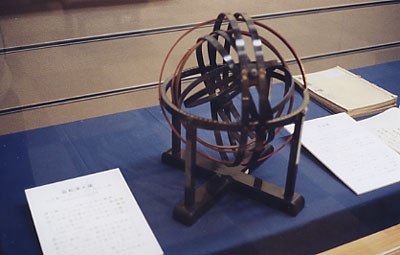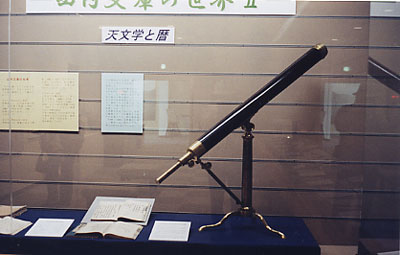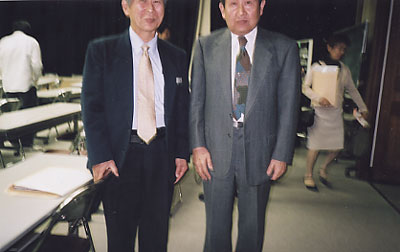• November 18
I have been to the exhibition called "Astronomy and
Almanacs" at Kochi Prefecture Literature Museum. They were displaying
an astronomical telescope, armillary sphere, diary-like records related
to almanacs of the Edo period.
The builder of the telescope was given as unknown, but it
is a telescope built about 200 years ago by Schneider, a German company.
There was also an inscription of Fraunhoffer on the telescope. This may
have been jointly made by these two companies. It looks like a terrestrial
telescope but is genuinely an astronomical telescope because it is equipped
with the (32mm barrel) American-standard eyepieces as well as a solar filter.
The telescope was probably used by forward-looking daimyo and samurai during
Lord Yodo Yamauchi's rule.
How would the stars appear through this telescope? Everybody
must be curious. Believe it or not, there was a man who actually looked
through this telescope! He dared to take the telescope out of the treasure
house secretly and observed great Halley's Comet. Who in the world committed
this sort of "reckless" act? How did Halley's Comet of 1986 appear
through the lenses of this telescope, a treasure of the Yamauchi family.
Nobody will see Halley's Comet again through this telescope. I will tell
you about this in the future.
Now it is about the armillary sphere. This was built by Keizan
Kawatani, an almanac scholar of Tosa around 1760. It was beautifully made
with brass. In those days observations might have been made using equipment
like this. This could have been used for prediction of that particular
solar eclipse. It was the year 1762. Keizan claimed that that year's government
almanac failed to predict the eclipse of September 1. However, it became
controversial as the astronomy officials of the Shogunate rejected the
claim.
It turned out that Keizan's calculation was correct. At Mt.
Hijima-yama in Kochi City, he witnessed a solar eclipse at noon on September
1, 1762, which made him smile with a total satisfaction.
One hundred and fifty years later, on August 15, 1945 (the
day when the war ended), I was standing at the summit of Mt. Hijima-yama.
There was an unmanned shrine at the summit where many picture prayer plaques
were hung. Among those plaques I found one with an unusual picture, quite
different from the rest of them and was difficult to make out. I am not
sure but it looked like a drawing of a solar eclipse. There was also an
old stone memorial erected at the entrance of a dark cave at the back of
the shrine. It could have been a memorial to mark the site where that solar
eclipse was observed. Later, all these sites were completely wiped out
by landslides.
Tosa produced celestial almanac scholars such as Jinzan Tani,
a predecessor of Keizan, leading the development of astronomy in early
Japan. However, it was of bygone eras and Tosa is now one of the most scientifically
backward provinces of the country.

The armillary sphere built by Keizan Kawatani
(possession of the Yamauchi family)

The 80-mm refractor (possession of the Yamauchi family)
With three speakers from the National Astronomical Observatory
of Japan attending, an astronomy seminar on the ALMA project was held today
at Kochi Prefectural Education Center in Kochi City. It attracted very
keen astronomy enthusiasts from Kochi City as well as other cities and
concluded with great success. However, I was surprised to find student
participants including senior high school students were fewer than expected.
It could be indicative of the recent trend of young people becoming disinterested
in sciences. I think this is a worrying development for us.
At a seminar like this I often run into people I never expect
to see. About 20 years ago when we had a seminar at Yokkaichi City, a woman
in her 30s with a school-age child came to see me in the guests' waiting
room. She introduced herself. "Hello, Mr. Seki. It's been a long time
since I last saw you. My name is Mrs. M. I learned guitar from you a long
time ago. I am so pleased to be able to see you again." Soon I recognized
her. Not long after my discovery of Comet Ikeya-Seki, magazine reporters
including Mr. Seiichi Saeki, a non-fiction writer, came over to interview
me and shoot lesson scenes. Mrs. M was a college student at that time and
posed as a student for a photograph. "Mr. Seki, I had a crush on you
in those days. Perhaps you didn't notice it." I thought that she would
be able to say a "daring" thing like this because she was now
a mother of a child and enjoying a very stable family life. "Some
day I would like to visit Geisei Observatory with my child," she said.
Incidentally, she was born at Geisei village.
The same thing happened at today's seminar, not totally unexpected,
though. When my talk was finished, a gentleman who was seated at the front
of the hall, walked straight over to me and said, "Hello, Mr. Seki.
I am Kataoka. It's been 53 years since we last met." I had a glance
at his business card to find his title Director, Board of Education, Town
of Ochi. He also serves as director of the town's museum. Immediately,
my memory took me back to 1952. It was soon after I joined OAA and began
observing. An elementary school student at Ochi built a celestial globe
and won a prize at a certain event, which was headlined in Kochi Shinbun
Newspaper. When I read the article, I was so moved that I wrote him with
my praises and encouragement. Four years later, when my discovery of Comet
Crommelin was reported, he sent me a letter to congratulate me on my discovery.
He was a junior high school student at that time. I hadn't had a chance
to see him until today's seminar. Although he did not go into astronomy,
the letter of encouragement from me may have influenced him positively.
This reminds me of a letter I had received from my mentor Mr. Minoru Honda.
Young people today find cell phones a convenient medium for
easy communication and would not be easily moved or brought to tears by
reading letters. But I know how important just a single letter can become
to us. My life has been changed forever by one letter from one person.

With Mr. Shigeatsu Kataoka (left)
Geisei Observatory is crowded with visitors daily for the
"Mars Observing Week". It was clear tonight, too, and children
from Akano Elementary School of Aki City visited the observatory accompanied
by teachers. Their voices were so loud that they could split the dome!
Although the moon a little younger than first quarter was shining brightly,
it was a beautiful starry night with crystal clear air.
Mars viewing for the visitors finished before 9 pm and I
began observing using the 60cm reflector and 21 cm Epsilon reflector simultaneously
as usual. The buildings housing these two telescopes are about 30 meters
apart and I shuttled between them about 20 times. I was able to make photographic
observations efficiently owing to the 60cm telescope's excellent guiding
accuracy. The guiding errors are often less than 1" without touching
the telescope for 15 minutes. This accuracy allows me to use the 21cm telescope
at the same time. Even visual search of a comet can be done.
With the 60cm telescope I targeted P/2005 U1 and recently
discovered 19th- to 20th-magnitude faint comets tonight. I am not quite
sure if these comets were captured on the film. It was tiring to observe
throughout night until morning after arriving at the observatory at 5 pm
on the previous day. Finally, I searched the pre-dawn eastern sky, while
an exposure on the 21cm telescope was going on.
I searched the area around Leo while conscious of limited
observing time. About 4.30 am, I caught NGC 3521 south of Leo. This has
been a familiar object to me since my discovery of 1961f (C/1961 T1) and
is recorded in my "memorized" star charts. For practice I sketched
the field of view. As I hadn't done sketching recently. It was not easy.
It would be useful to make the scale of the sketch identical with that
of the star charts. For example, when a star chart's scale is 2cm per degree,
you draw a 6-cm diameter circle to match the 3-degree field of view of
the 12cm Nikon binoculars. I almost forgot this sort of basic things as
a result of my long-time neglect.
Whenever I have time, I draw circles with compasses on plain
white paper. Now these "circles" are everywhere, on my observing
desk and in its drawers. By looking at them, I feel my passion for comet
search has never faded. Even while operating the 60cm reflector, I am always
aware that I am a comet hunter.
• November 3
This is November 3, the Culture Day public holiday. The Culture
Day has a high probability of clear skies, but it has been cloudy today
and even drizzled.
Since the end of October, meteors have been frequently seen.
I wonder if this is the Taurid meteor shower originated in Encke's Comet.
I remember seeing surprisingly many fireballs in the 1950s. The year must
be 1954, because that year the second Comet Conference (initiated by Dr.
Issei Yamamoto) was held at Takatsuki City. I recall that Mr. Kojiro Komaki
told us that that year's Encke's meteoric swarm(*) had been accompanied
by many fireballs.
An acquaintance of ours told me that he had seen huge fireworks
exploding in the sky and lighting up the whole landscape like daytime two
days ago. He got up at 5 am and was "taking in light and energy from
the universe" at that time. It must have been caused by a huge fireball.
(*) Encke's comet is the parent body of the Taurid Meteoroid Stream.
• November 1
Transparent late-fall blue skies are now glowing above us.
Around this time year 40 yeas ago, I was literally running around furiously,
rushing to the beaches and mountains around Kochi City, desperate for a
glimpse of Comet Ikeya-Seki. The image of the graceful comet with its long
narrow tail streaming behind in the cool fall sky, is still deeply etched
in my mind.
A composer called Jose Caleyo living in Havana, Cuba, sent
me his composition titled "Ikeya-Seki". The hand-written notes
on the score read: "I composed this music spontaneously when I heard
about the discovery of Comet Ikeya-Seki. This is dedicated to the two Japanese
discoverers. A comet will shine some day when this music is played."
This music score had been stored away for 40 years until
I found it lately. The discoverers of the comet themselves haven't heard
this music yet. Couldn't somebody play this music? Which comet will shine
when the music is played? Each note on the score accompanied by vigorous
rhythm stirs up my memory and emotion of the discovery.
The memory of Comet Ikeya-Seki will never fade away.




